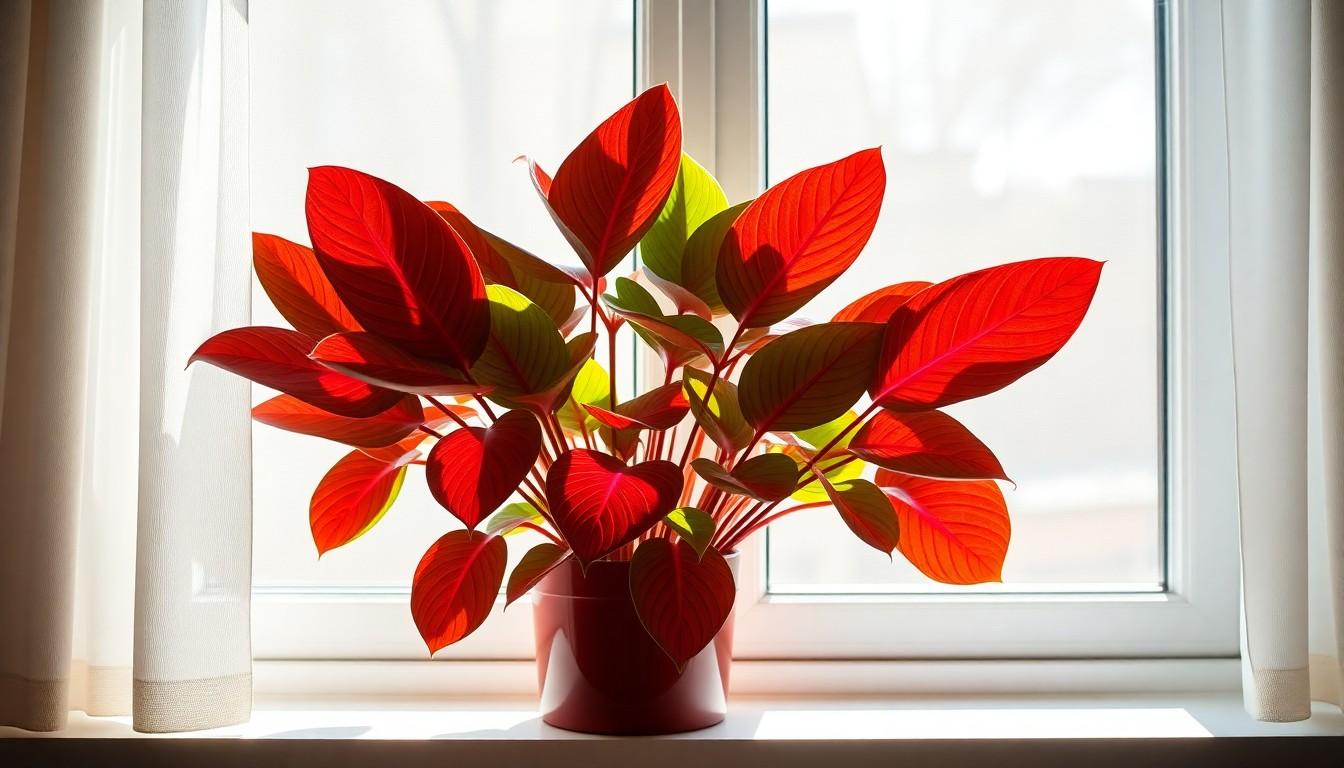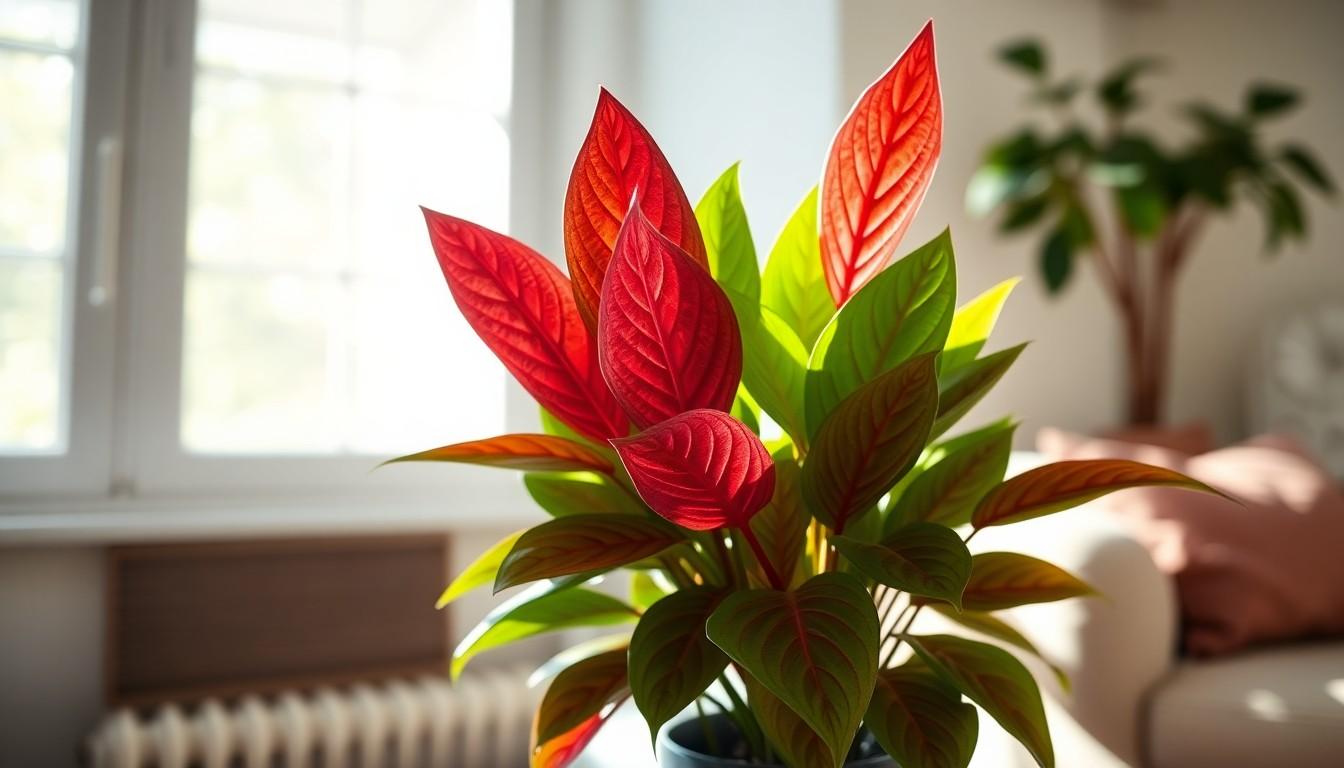If you’re looking to add a splash of vibrant color to your indoor garden, the red prayer plant is your go-to green companion. With its stunning, deep red veins and lush green leaves, this plant doesn’t just sit pretty; it’ll have you feeling like a botanical wizard in no time. But before you rush off to snag one, let’s talk about keeping this beauty thriving.
Red Prayer Plant Care
Red prayer plants thrive in specific conditions. Providing bright, indirect sunlight supports their growth and enhances their vibrant colors. An east-facing window often serves as the ideal location for these plants. Watering should occur when the top inch of soil dries out; keeping soil consistently moist promotes health.
Humidity contributes significantly to their wellbeing. Maintaining humidity levels between 50% and 70% can prevent leaf curling or browning. Grouping plants together or using a humidifier achieves this environment. Fertilization every four to six weeks during the growing season with a balanced liquid fertilizer ensures proper nutrient uptake.
Temperature plays a crucial role in care practices. These plants prefer temperatures ranging from 65°F to 85°F. Exposure to temperatures below 50°F risks damage and may lead to stress symptoms. Pruning helps maintain the desired shape and encourages bushier growth.
Pests can pose challenges but can be managed effectively. Regularly inspecting for spider mites and aphids allows for prompt intervention. Utilizing insecticidal soap or neem oil minimizes infestations and promotes plant health. Repotting every couple of years refreshes soil quality and provides space for growth.
Monitoring for signs of stress is essential. Yellowing leaves can indicate overwatering, while brown tips often suggest underwatering. Taking immediate action helps prevent further damage and manage recovery. With the right care, red prayer plants remain vibrant, adding striking visual appeal to indoor spaces.
Light Requirements
Red prayer plants thrive in specific lighting conditions. Bright, indirect sunlight enhances their vibrant colors and ensures healthy growth.
Ideal Light Conditions
Optimal light comes from east-facing windows. These locations provide sufficient brightness without exposing the plant to harsh direct sunlight. If an east-facing window isn’t available, filtering light with sheer curtains helps. They can also adapt to lower light conditions but may exhibit slower growth. Positioning the plant in bright spots stretches the deep red veins and lush green leaves, keeping them visually appealing.
Signs of Improper Lighting
Plants exhibit signs when light conditions aren’t suitable. Yellowing leaves indicate insufficient light, while fading colors denote excessive exposure. Leaf curling or leggy growth often result from poor light distribution. Observing these symptoms allows for timely adjustments. Moving the plant closer to a better light source prevents further stress. Monitoring light levels proves essential in maintaining plant health and vibrancy.
Watering Techniques
Proper watering techniques are essential for the health of the red prayer plant. This plant thrives in consistently moist soil, but overwatering can lead to root rot.
Frequency of Watering
Watering frequency varies based on environmental factors. Typically, checking the soil moisture weekly works well. When the top inch of soil feels dry, it’s time to water. During the growing season, plants may require more frequent watering, while in winter, the frequency can decrease. Monitoring moisture levels closely prevents both overwatering and underwatering, which allows the plant to remain vibrant.
Best Practices for Watering
Implementing best practices ensures optimal growth for the red prayer plant. Always use room temperature water to avoid shocking the roots. A pot with good drainage is crucial for preventing excess water accumulation. Water thoroughly until it drains from the bottom, ensuring the roots receive adequate moisture. Additionally, misting the leaves enhances humidity levels, which promotes lush growth. Always observe the plant for signs of distress, adjusting watering practices as necessary.
Soil and Potting
Proper soil and potting techniques ensure the health of red prayer plants. Selecting the right components directly impacts their growth and vibrancy.
Recommended Soil Mix
A well-draining soil mix supports red prayer plants. A combination of potting soil, peat moss, and perlite creates an ideal environment. Perlite promotes aeration, while peat moss retains necessary moisture. The soil pH should range between 6.0 and 7.0, fostering nutrient availability. Regularly checking for compacted soil ensures roots receive adequate air and water. Choosing a soil blend tailored for tropical plants also enhances the overall health of the red prayer plant.
Choosing the Right Pot
Selecting the appropriate pot is essential for red prayer plant growth. A pot with drainage holes prevents excess water, reducing the risk of root rot. Clay or terracotta pots absorb moisture, which balances humidity levels. Opting for a slightly larger pot during repotting allows room for growth without causing stress. Regularly checking root development guides when to repot; signs include roots growing from drainage holes. Overall, the right pot promotes healthy root systems and supports flourishing foliage.
Humidity and Temperature Needs
Humidity and temperature significantly impact the health of the red prayer plant. Maintaining the right levels ensures vibrant growth and prevents issues.
Maintaining Humidity Levels
Humidity levels between 50% and 70% are essential for red prayer plants. Grouping plants together often creates a microclimate with higher humidity. Using a humidifier improves moisture in the air, especially in dry environments. Misting leaves provides an extra boost of humidity, supporting lush foliage. Furthermore, placing a pebble tray filled with water beneath the pot can enhance humidity without over-saturating the soil.
Ideal Temperature Range
The ideal temperature range for red prayer plants falls between 65°F and 85°F. Keeping plants away from drafts helps protect them from temperature fluctuations. It’s crucial to monitor temperatures during colder months since exposure below 50°F can cause stress and damage. Using thermometers ensures that indoor temperatures remain consistent and suitable. Additionally, placing plants in well-insulated areas prevents sudden drops in temperature, facilitating optimal growth conditions.
Fertilization and Feeding
Fertilizing red prayer plants supports their growth and vibrancy. Balanced, liquid fertilizers work well for these plants. Opt for fertilizers with equal ratios of nitrogen, phosphorus, and potassium, typically labeled as 10-10-10 or 20-20-20. Organic options such as fish emulsion or seaweed extract also provide beneficial nutrients without risking chemical buildup.
Types of Fertilizers
Many types of fertilizers suit red prayer plants. Balanced fertilizers offer essential nutrients for overall health. Slow-release fertilizers provide nutrients gradually, avoiding the risk of over-fertilization. Organic fertilizers, like compost or worm castings, enhance soil health while promoting beneficial microbes. Selecting the right fertilizer depends on personal preference and plant needs.
Feeding Schedule
A consistent feeding schedule supports robust growth. During the growing season, generally from spring to early fall, fertilize every four to six weeks. Reduce frequency in winter when the plant’s growth slows. Always water the plant thoroughly after fertilizing to prevent root burn and ensure nutrient absorption. Observing the plant’s condition helps determine if adjustments are needed.
Common Pests and Diseases
Red prayer plants can face several pests and diseases that threaten their health. Identifying common issues early helps maintain their vibrant appearance.
Identifying Common Issues
Spider mites are a frequent problem, appearing as tiny specks on leaves. Aphids may cluster on the undersides, sucking sap from the plant. Fungal infections can lead to leaf spots, often resulting from too much moisture. Root rot from overwatering can also occur, causing yellowing leaves and stunted growth. Regular inspections for these pests and symptoms are crucial for prompt action.
Treatment and Prevention
Insecticidal soap effectively treats spider mites and aphids, ensuring minimal damage. Neem oil serves as a natural remedy, providing pest control without harsh chemicals. Maintaining proper watering practices prevents root rot and promotes soil drainage. Increasing humidity through misting or using pebble trays can deter spider mites. Regularly pruning affected leaves helps improve airflow and prevent fungal diseases, promoting overall plant health.
Helping Plant Maintain Beauty
Caring for a red prayer plant can bring vibrant beauty to any indoor space. By providing the right light humidity and temperature conditions, these plants can thrive and remain healthy. Regular attention to watering and fertilization will ensure they grow lush and vibrant.
Monitoring for pests and addressing any issues promptly will help maintain their beauty. With proper care and attention, a red prayer plant can be a stunning addition to any indoor garden. Embracing these practices will allow anyone to enjoy the full splendor of this unique plant for years to come.



